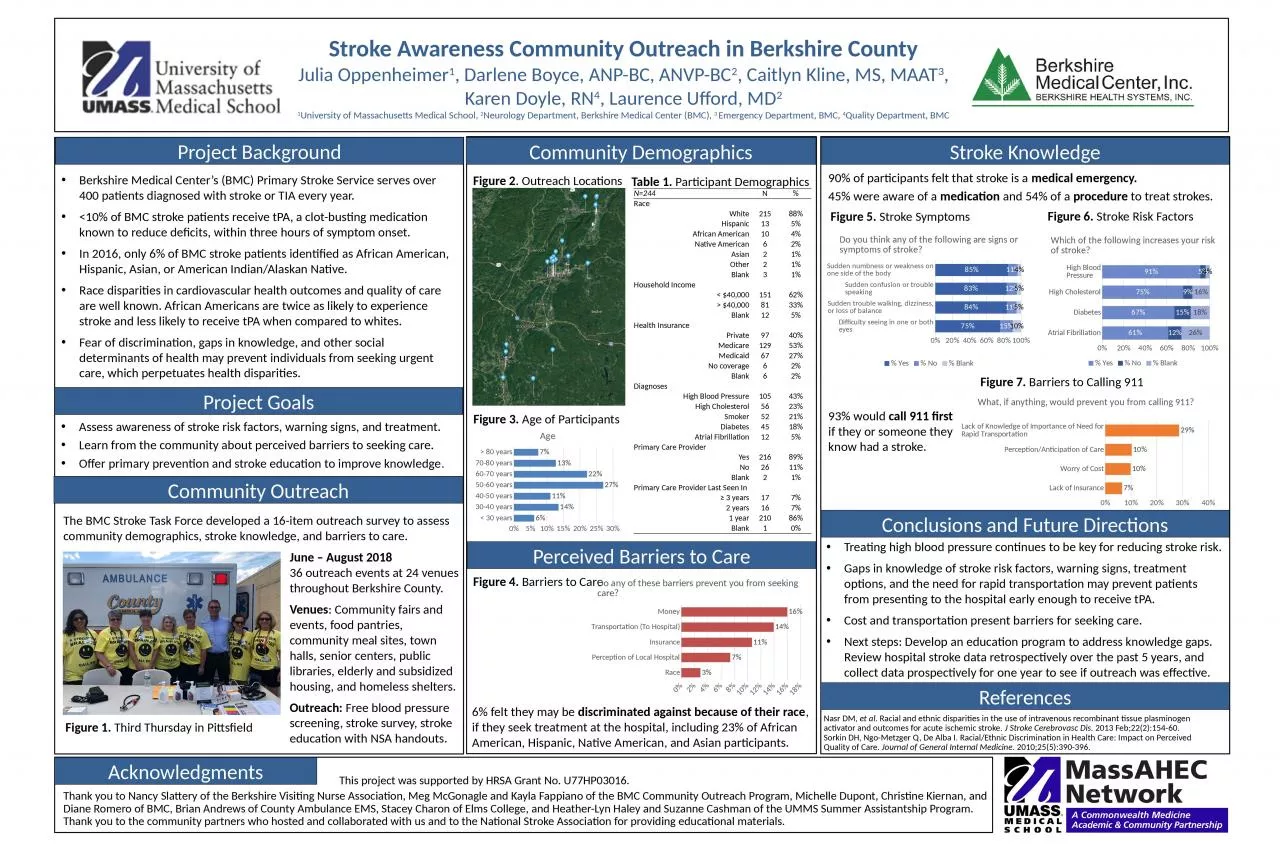

June August 2018 36 outreach events at 24 venues throughout Berkshire County Venues Community fairs and events food pantries community meal sites town halls senior centers public libraries elderly and subsidized housing and homeless shelters ID: 931139
Download Presentation The PPT/PDF document "The BMC Stroke Task Force developed a 16..." is the property of its rightful owner. Permission is granted to download and print the materials on this web site for personal, non-commercial use only, and to display it on your personal computer provided you do not modify the materials and that you retain all copyright notices contained in the materials. By downloading content from our website, you accept the terms of this agreement.
Slide1
The BMC Stroke Task Force developed a 16-item outreach survey to assess community demographics, stroke knowledge, and barriers to care.June – August 2018 36 outreach events at 24 venues throughout Berkshire County.Venues: Community fairs and events, food pantries, community meal sites, town halls, senior centers, public libraries, elderly and subsidized housing, and homeless shelters.Outreach: Free blood pressure screening, stroke survey, stroke education with NSA handouts.
Stroke Awareness Community Outreach in Berkshire CountyJulia Oppenheimer1, Darlene Boyce, ANP-BC, ANVP-BC2, Caitlyn Kline, MS, MAAT3, Karen Doyle, RN4, Laurence Ufford, MD21University of Massachusetts Medical School, 2Neurology Department, Berkshire Medical Center (BMC), 3 Emergency Department, BMC, 4Quality Department, BMC
Acknowledgments
Thank you to Nancy Slattery of the Berkshire Visiting Nurse Association, Meg McGonagle and Kayla Fappiano of the BMC Community Outreach Program, Michelle Dupont, Christine Kiernan, and Diane Romero of BMC, Brian Andrews of County Ambulance EMS, Stacey Charon of Elms College, and Heather-Lyn Haley and Suzanne Cashman of the UMMS Summer Assistantship Program. Thank you to the community partners who hosted and collaborated with us and to the National Stroke Association for providing educational materials.
Berkshire Medical Center’s (BMC) Primary Stroke Service serves over 400 patients diagnosed with stroke or TIA every year.
<10% of BMC stroke patients receive
tPA
, a clot-busting medication known to reduce deficits, within three hours of symptom onset.
In 2016, only 6% of BMC stroke patients identified as African American, Hispanic, Asian, or American Indian/Alaskan Native.
Race disparities in cardiovascular health outcomes and quality of care are well known. African Americans are twice as likely to experience stroke and less likely to receive
tPA
when compared to whites.Fear of discrimination, gaps in knowledge, and other social determinants of health may prevent individuals from seeking urgent care, which perpetuates health disparities.
Project Goals
Community Outreach
Project Background
Assess awareness of stroke risk factors, warning signs, and treatment.Learn from the community about perceived barriers to seeking care.Offer primary prevention and stroke education to improve knowledge.
Figure 1. Third Thursday in Pittsfield
This project was supported by HRSA Grant No. U77HP03016.
Stroke Knowledge
Conclusions and Future Directions
90% of participants felt that stroke is a
medical emergency.45% were aware of a medication and 54% of a procedure to treat strokes.
Treating high blood pressure continues to be key for reducing stroke risk.Gaps in knowledge of stroke risk factors, warning signs, treatment options, and the need for rapid transportation may prevent patients from presenting to the hospital early enough to receive tPA.Cost and transportation present barriers for seeking care.Next steps: Develop an education program to address knowledge gaps. Review hospital stroke data retrospectively over the past 5 years, and collect data prospectively for one year to see if outreach was effective.
References
Nasr DM, et al. Racial and ethnic disparities in the use of intravenous recombinant tissue plasminogen activator and outcomes for acute ischemic stroke. J Stroke Cerebrovasc Dis. 2013 Feb;22(2):154-60.Sorkin DH, Ngo-Metzger Q, De Alba I. Racial/Ethnic Discrimination in Health Care: Impact on Perceived Quality of Care. Journal of General Internal Medicine. 2010;25(5):390-396.
Figure 2. Outreach Locations
Community Demographics
Table 1.
Participant Demographics
Figure 3. Age of Participants
Perceived Barriers to Care
Figure 5. Stroke Symptoms
Figure 6. Stroke Risk Factors
6% felt they may be discriminated against because of their race, if they seek treatment at the hospital, including 23% of African American, Hispanic, Native American, and Asian participants.
Figure 4. Barriers to Care
93% would call 911 first if they or someone they know had a stroke.
Figure 7. Barriers to Calling 911
N=244
N%RaceWhite21588%Hispanic135%African American104%Native American62%Asian21%Other21%Blank31%Household Income< $40,00015162%> $40,0008133%Blank125%Health InsurancePrivate9740%Medicare12953%Medicaid6727%No coverage62%Blank62%DiagnosesHigh Blood Pressure10543%High Cholesterol5623%Smoker5221%Diabetes4518%Atrial Fibrillation125%Primary Care ProviderYes21689%No2611%Blank21%Primary Care Provider Last Seen In≥ 3 years177%2 years167%1 year21086%Blank10%